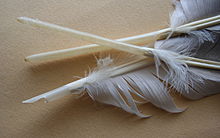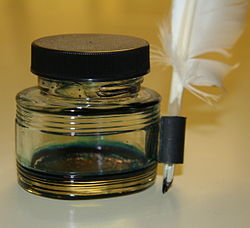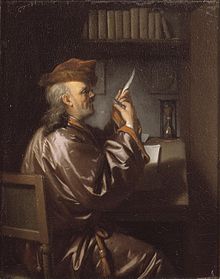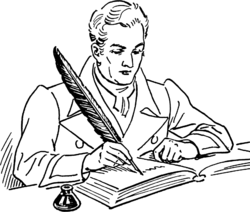- Quill
-
A quill pen is a writing implement made from a flight feather (preferably a primary wing-feather) of a large bird. Quills were used for writing with ink before the invention of the dip pen, metal-nibbed pens, the fountain pen, and, eventually, the ballpoint pen. The hand-cut goose quill is still used as a calligraphy tool, however rarely because many papers are derived from wood pulp and wear down the quill very quickly. Nevertheless, it is still the tool of choice for a few professionals and provides a sharp stroke as well as greater flexibility than a steel pen. The hollow shaft of the feather (the calamus) acts as an ink reservoir and ink flows to the tip by capillary action.
The strongest quills come from the primary flight feathers discarded by birds during their annual moult. Generally the left wing is favored by the right-handed majority of writers because the feathers curve out to the right, away from the hand holding the pen, but because of the current scarcity of substantial quills this is usually overlooked as the curvature is not actually so pronounced as to cause any difficulty to the professional.
Goose feathers are most commonly used; scarcer, more expensive swan feathers are considered premium. Depending on availability and strength of the feather, as well as quality/characteristic of the line wanted by the writer, other feathers used for quill-pen making include feathers from the crow, eagle, owl, hawk, and turkey. The barbs are always stripped off partially or completely as they are an impractical distraction. The fancy, fully plumed quill is mostly a Hollywood invention and has little basis in reality. Most, if not all, manuscript illustrations of scribes show a quill devoid of decorative barbs, or at least mostly stripped.
Quill pens were used to write the Magna Carta and the Declaration of Independence.
Quill pens are still used today by artists.
Contents
History
Quills were the principal writing instrument from the 6th to the 19th century, the best of which were usually made from goose and swan feathers, and later, turkey feathers, However, quills went into decline after the invention of the metal pen, first patented in America in 1810 and then mass produced by 1860.
Quill pens were very popular during the medieval era. Other than written text, they were often used to create figures, decorations, and images on manuscripts. The tip of the pen was also very flexible, which made easy a variety of different strokes.
According to the Supreme Court Historical Society, 20 goose-quill pens, neatly crossed, are placed at the four counsel tables each day the U.S. Supreme Court is in session; "most lawyers appear before the Court only once, and gladly take the quills home as souvenirs."[1] This has been done since the earliest sessions of the Court.[2]
Quills are denominated from the order in which they are fixed in the wing, the first called the pinion is that favoured by the expert calligrapher, the second and third quills being very satisfactory also. No other feather on the wing would be considered suitable by a professional scribe.
Information can be obtained on the techniques of curing and cutting quills[3]
"In order to harden a quill that is soft, thrust the barrel into hot ashes, stirring it till it is soft; then taking it out, press it almost flat upon your knees with the back of a penknife, and afterwards reduce it to a roundness with your fingers. If you have a number to harden, set water and alum over the fire; and while it is boiling put in a handful of quills, the barrels only, for a minute, and then lay them by."[4]
Today
A quill knife was the original primary tool used for cutting and sharpening quills, known as 'dressing'.
Following the decline of the quill in the 1820s, following the introduction of the maintenance-free, steel dip nib, knives were still manufactured but became known as desk knives, stationery knives or latterly as the name stuck 'pen' knives. There is a small but significant difference between a pen knife and a quill knife, in that the quill knife has a blade that is flat on one side and convex on the other, which facilitates the round cuts required to shape a quill.
A 'pen' knife by contrast has two flat sides. This distinction is not recognised by modern traders, dealers or collectors who define a quill knife as any small knife with a fixed or hinged blade, including such items as ornamental fruit knives.
See also
References
- ^ "How the court works." Supreme Court Historical Society.
- ^ "The Court and Its Traditions." Supreme Court of the United States.
- ^ Child, Heather (1985). The Calligraphers Handbook. A & C Black UK. ISBN 071362695X.
- ^ Encyclopaedia Britannica, 6th edition, 1823.
External links
- Detailed & Referenced Instruction on Quill construction
- A brief history of writing instruments
- Quill Pens the 18th Century Way
- Tutorial on Medieval method of creating quills
Types ballpoint (biro) · demonstrator · digital · dip · fountain · gel · ink brush · light · porous point · qalam · quill · rastrum · reed · rollerball · ruling · skin · stylus · technical (rapidograph)Parts and tools pen inks Related Categories:- Feathers
- Writing instruments
Wikimedia Foundation. 2010.




